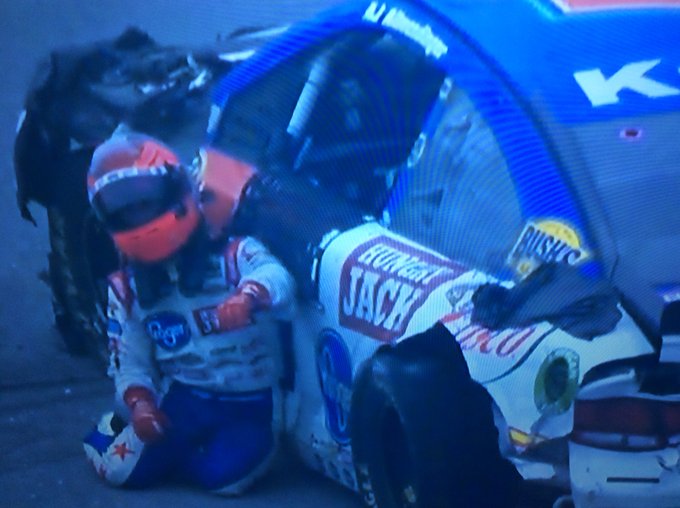Seriously. What do you call a race when 35 of the 40 cars are involved in some form of wreck, when several drivers stagger from their cars gasping for breath, when cars are hurtling toward walls fast enough for you to start thinking dark thoughts?
Look, strange things happen at Talladega. They always do. This desolate stretch of Alabama might be cursed, or might just be an epicenter of peculiarity. At the very least, it's racing's most unpredictable track, a place where any team can achieve victory and every team can expect to bring chassis and shredded sheet metal back to the shop.
It's a case of giving us what we want ... and being careful what we wish for.
Brad Keselowski won Sunday's GEICO 500, in large measure because he was in the safest place on the entire track: the front. He was one of the few that didn't end the day with damage ranging from the cosmetic to the catastrophic.
 The drivers were wrestling with more immediate concerns. Both Kenseth and Patrick allowed that they were a little nervous in the long instants before their cars collided with the wall. Kenseth said he prayed, while Patrick just closed her eyes ... until the fire started in the car, that is.
The drivers were wrestling with more immediate concerns. Both Kenseth and Patrick allowed that they were a little nervous in the long instants before their cars collided with the wall. Kenseth said he prayed, while Patrick just closed her eyes ... until the fire started in the car, that is.
Consider: Chris Buescher flipped three times. Danica Patrick upended Matt Kenseth. Kevin Harvick ended the day sliding across the fence on his roof. All in all, millions of dollars' worth of cars ended up totaled, with the only winners—besides Keselowski, of course—being the scavengers who prowled the garage throughout and after the race, carrying off a fender or a bumper or a chunk of brightly-painted sheet metal.
 The drivers were wrestling with more immediate concerns. Both Kenseth and Patrick allowed that they were a little nervous in the long instants before their cars collided with the wall. Kenseth said he prayed, while Patrick just closed her eyes ... until the fire started in the car, that is.
The drivers were wrestling with more immediate concerns. Both Kenseth and Patrick allowed that they were a little nervous in the long instants before their cars collided with the wall. Kenseth said he prayed, while Patrick just closed her eyes ... until the fire started in the car, that is.
"I would say that's probably the most scared, trying to hop out of a car with the fire on the inside," Patrick said. "I haven't had fire on the inside before. I have a pretty decent bruise on my arm and my foot, and my head feels like I hit a wall at 200. My chest hurts when I breathe." Patrick noted that X-rays taken after the crash were negative.
After another wreck, cameras captured A.J. Allmendinger staggering out of his car, slumping against the door:
And here's video from the stands of Harvick's car sailing past almost too fast for the eye to track:
Drivers seem to have reached a point of resignation here. "I don't have a solution [to the safety issues]," said Kyle Busch, who finished second. "It's been this way for 30 years, so, stop complaining about it, I guess."
"It's exciting," Patrick said. "I enjoy watching it too. But I do wish there wasn't so much distance between the track and the inside wall. There's a lot of time to build up momentum there."
"I went flying last year at Daytona, and that's not fun," Austin Dillon said. "I know NASCAR will put their efforts towards fixing it. I know they will. They've made the car safer. That's the reason why we're walking away from these crashes. I think as a group, all of us want it to be where we're not leaving the ground."
Keselowski could afford to be in a bit more charitable mood after the race, having his second win of the season and fourth at Talladega locked up. "That's how Talladega goes," he said. "Sometimes we run here and everybody kind of lines up against the wall, and sometimes we come here and it's crazy side‑by‑side, wreck 'em up, flip 'em. I think that's kind of the allure to coming here, because you don't know what you're going to get."
That allure has always been the troubling heart of racing. We watch to see these drivers throw themselves out to the bleeding edge of mechanical and human tolerance, to take risks that we couldn't imagine. The trouble with risk is that sometimes the threat you're risking becomes a reality. Speed creates wrecks, cars go airborne, and we all hold our breath, knowing that this is what can happen but hoping everyone walks away.
"We don't like to be a part of crashes. It's not what our job is, is to crash," Dillon said. "Our job is to compete and have fun out there and put on a show. Putting on a show, crashes happen ... I think people, if they're cheering for crashes, man, it's not a good thing."
But this is the eternal conundrum of NASCAR. Without risk, there's no challenge. With no challenge, there's no drama. And with no drama, there's no reason to watch. When you get down to it, the danger, or the possibility of it, generates the true fuel that powers racing: cash.
"I'm a capitalist. I love capitalism," Keselowski said. "There's still people paying to sit in the stands, sponsors still on the cars, drivers still willing to get in them. There's self‑policing and enough interest to keep going, so we'll keep going."



No comments:
Post a Comment